Italy – Golf and More…
We travel to the Friuli Venezia Giulia region of Italy to see what it can offer visiting golfers
It’s six years until the 2022 Ryder Cup takes place, but awarding this prestigious golfing event to Rome’s Marco Simone Golf Club has triggered a flurry of promotional activity within Italy. In a concerted effort to show the world exactly what the country can offer visiting golfers, Italy Golf & More, was launched earlier this year and this enterprising project is a collaboration between eleven private sector partner regions, the Italian Golf Federation and the Ministry of Tourism, all of whom joined forces to publicise the nation as a forward-looking golf destination.
Using the recent Italian Senior Open in Udine as the focal point for its latest promotion, the consortium commissioned The Azalea Group, the respected UK golf public relations and marketing company with an enviable list of international clients, to lead a small press pack of journalists on a tour of the autonomous Friuli Venezia Giulia region. Over the course of five days, the group was given the chance to spend some time in a couple of historic towns, sample a little of the excellent local cuisine, and squeeze in a few games of golf at a few of the best 18-hole courses in the district.
Located in the northeast corner of Italy, where it borders Austria to the north and Slovenia to the east, Friuli Venezia Giulia occupies a diverse landscape of just under 8,000 square kilometres, stretching from the peaks of the Carnic and Julian Alps, through the foothills and plains of Friuli and the Karst, to the lagoons of Marano and Grado on the shoreline of the Adriatic Sea. It’s a district that can trace the origins of the Roman ruins at Aquileia back to 181 BC and it has seen Austrian, Slavic and Italian influences all vie for dominance at various times during the two millennia since then.

The guarantee of a €7 million prize pot for the Italian Open for eleven years was a major financial inducement that helped win the Ryder Cup bid and another golfing commitment promised was the reintroduction of the Italian Senior Open to the European Senior Tour calendar. With businessman Gabriele Lualdi having invested heavily in the infrastructure at Golf Club Udine – including the construction of the Villaverde Hotel, spa and state-of-the-art medical centre next to the clubhouse – it seems only right to have the Senior Open revitalised here this year, rewarding a progressive club which has invested heavily in the future of golf in Italy.

Originally laid out as a 9-hole design by John Harris and Marco Croze in 1972, the Udine course was later extended to a full 18-hole track by the same Italian architect. Following Mr Lualdi’s acquisition in 2013, the layout is undergoing a gradual renovation process, with holes upgraded in a rolling program by another designer, Fulvio Bani. Unfortunately, heavy rain led to the cancellation of the eagerly anticipated Senior Open pro-am, regrettably leading to a curtailment of journalistic participation in the event. Play in the tournament itself did get under way the following morning as scheduled, allowing the three-day event to proceed as planned, with Welshman Stephen Dodd eventually holding off a strong challenge from compatriot Phillip Price to win his first Senior title by one-shot in only his seventh Senior tournament.
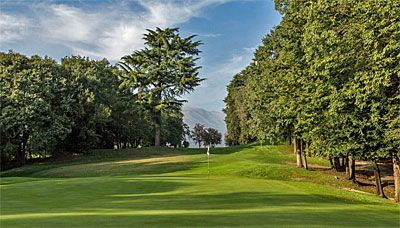
Sixty-three kilometres west of Golf Club Udine, Castel d’Aviano Golf Club lies between the charming little town of Pordenone and the Piancavallo ski centre. Set within a 55-hectare property inside the 16th-century Villa Policreti estate, the tree-lined fairways are laid out in two distinct 9-hole circuits, with holes 3 to 11 sitting in a separate, self-contained parcel of land. Water hazards come into play at three holes on the back nine, most notably at the 331-metre 17th, where a pond protects the front left side of the green.

An hour’s drive northeast of Udine, via the A23 Alpe Adria highway, Golf Senza Confini Tarvisio is situated in the very top right hand extremity of the country as you look at a map of Italy. Originally designed by Giacomo Cabrini in 1992 then expanded a decade later by Graham Cooke, the course lies on the Priesnig plateau, some 750 metres above sea level, with the Austrian and Slovenian borders located less than 15 kilometers away. Mount Mangart looms in the background and Tarvisio Forest surrounds the course in what is simply a sensational location for playing golf.
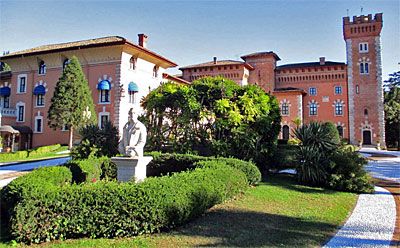
Although there wasn’t enough time in a packed itinerary to see either the d’Aviano or Tarvisio courses, an outing to Castello di Spessa more than made up for this. The 13th-century castle lies in the heart of the Collio Goriziano, one of the most prolific wine-producing regions in Italy, and this magnificent building has now been converted into a 15-bedroomed hotel. Ageing cellars beneath the castle house wine barrels on one level and bottles of red wine in a second, lower level which was once a military bunker built by the Italian army in 1939 and only rediscovered during restoration work. Its constant 14°C temperature is ideal for ageing both the Cru del Castello red wines and Grappa Riserva Conte Ludovico.

Giacomo Cabrini designed the Castello di Spessa Golf & Country Club course that lies to the south west of the castle and the fairways are set out in an easy-walking, parkland setting. By far the most interesting sequence of holes during the round is played between the 4th and the 8th, which weave their way through vineyards that are sited on hillier ground. The 132-metre 5th, requiring a tee shot from an elevated position over rows of vines to a raised green on the other side of the vineyard, is easily the best hole on the card and one of the most unique par threes that you could ever imagine playing anywhere.

After a sumptuous lunch in the Tavernetta al Castello, a gourmet restaurant and 10-bedroom hostelry converted from old farmers’ cottages, it was on to have a look around the border town of Gorizia. It’s here that Charles X of France died in 1836, when it was part of the Kingdom of Illyria, a crown land in the Austrian Empire. Gorizia Castle overlooks the old town, with Nova Gorica located on the other side of the border with Slovenia. This conurbation is sheltered by a mountain ridge to the north, protecting it from the cold Bora wind that affects other places in the locality, allowing residents to enjoy a year-round Mediterranean climate.
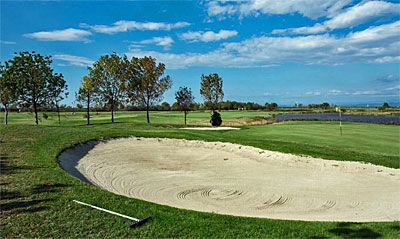
Returning to Udine, the final night’s stay in the city was marked with dinner at Trattoria Ai Frati, a family-run restaurant serving regional specialties such as frico and polenta and tagliatelle with rabbit ragout and porcini mushrooms. Next morning, the exploration of the Friuli Venezia Giulia hinterland over, it was time to leave base camp at the comfortable Hotel Astoria in Udine and head for the coast, where Austro-Hungarian Emperors are reputed to have spent their summers in the spa town of Grado. The course is operated by the Tenura Primero resort and it was recently ranked in a golf magazine’s inaugural Top 100 Resorts in Continental Europe chart. Fairways are set out along the lagoon so there’s water in play at most of the holes, none more so than at the par five 11th, which plays to an island green. If you can finish a round here with the same ball you started with then you’re some player!
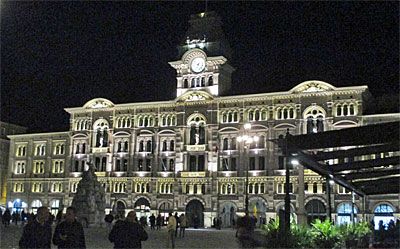
After completing eighteen holes, another magnificent lunch ensued in nearby Ristorante Tarabusino before the group set off on the one-hour road journey to Trieste. In truth, after checking into the Gran Hotel Duchi D’Aosta there wasn’t really enough time before darkness fell to properly explore this wonderful city of around a quarter of a million inhabitants, apart from having a quick look around the narrow streets of the old city and taking a short walk around the Piazza Unita d’Italia. Sadly, the “Nice of the Adriatic” remains largely undiscovered by the group of journalists – though dinner at Roberto Marussi’s 50-year-old family Ristorante Al Bagatto will long be remembered – so a return visit may have to be taken some day to see more of the sights, perhaps as a disembarking passenger on a day trip from one of the large cruise liners that dock right in the heart of the city?
Golf Club Trieste is the oldest golf club in the region, formed by members of the Allied forces that were based in the area after the end of World War II. The layout opened for play in 1955 and it extends today to 5,810 metres, playing to a par of 70. Laid out above the city at an altitude of 350 metres above sea level, the course affords golfers majestic views across the Gulf of Trieste to the Grado and Lignano lagoons. Feature holes include long par fours at the left doglegged 8th and the 17th, which is hampered by out of bounds down the left side. It’s a pity there was no opportunity to play the course on this occasion but that’s another good excuse for arranging a future trip to Trieste!

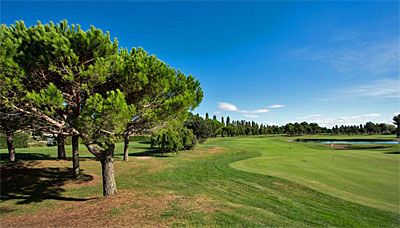
The tour ended at Lignano Golf Club, situated between the Tagliamento River estuary and the Marano lagoon, where the Italian Ladies’ Open in 1993 and 1994 was hosted. The fairways of this course are routed around a gently undulating landscape close to the sandy beaches of the Adriatic shoreline. Four holes on the front nine (at 4 & 6 to 8) and three on the back nine (at 12 to 14) flirt with water hazards and there are a couple of large, sandy waste areas to negotiate at the 9th and the 15th. The best hole is also the most difficult: the 402-metre 13th, rated stroke index 1, requires a solid tee shot across an intimidating wetland area to reach the fairway before heading for the green.

The 24-bedroomed Hotel Golf Inn Lignano is attached to the clubhouse at the golf club, presenting golfers with a range of tempting stay and play options, based on their choice of accommodation. Guests can also relax in the well-appointed, modern wellness facility, making use of the sauna, steam room, Turkish baths and tepidarium. With such a top-class leisure facility on the doorstep of the golf club, there’s really no good excuse for not indulging in a little golf-related pampering after a round at Lignano.
Before returning to Venice for the flight back to the UK, the press trip was rounded off with a final lunch in the countryside near Gorgo di Latisana at the lovely little unassuming Ristorante Da Boschet, which specialises in seafood dishes. It was a wonderful way to round off a truly memorable excursion, eating local wild-caught fish and drinking some of the best wines produced in the area. In many ways, the last day encapsulated everything the Friuli Venezia Giulia region is capable of offering golfers – good golf and wellbeing for body and soul, the discovery of countryside secrets and cuisine of the highest order. This particular part of Italy might not be high on your list of potential golfing destinations – but it should be.
Jim McCann
Editor
Top 100 Golf Courses
